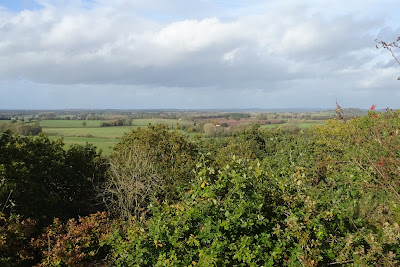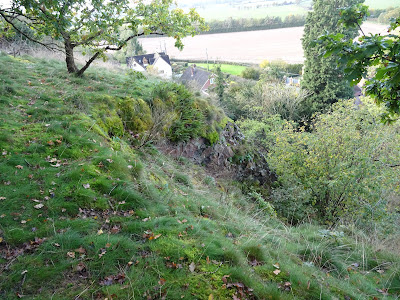Wednesday 1st November 2023, Lilleshall Hill LNR
As we move into November the completion of the latest Joy of Wildlife programme does not mean that the group can put its collective feet up and sit in front of the fire, warm and cosy.
We carry on.
There is no formal programme during the winter. Sites are decided just a week or so in advance.
Normally we try to find suitable woodland as this generally provides more shelter from the elements than open grassland and gives us a chance of finding our favourite winter animal – Boreus hyemalis (snow flea). They can be found, usually associated with Polytrichum moss, between November and February.
As we had postponed a few trips recently, due to bad weather, we decided that the first two visits of the winter schedule would be to Lilleshall Hill and Lyth Hill. The third postponement, to the pair of Shropshire Wildlife Trust sites at Mason’s Bank and Lower Shortditch Turbary, at over 450m altitude, considerable higher than Lilleshall and Lyth Hills, could be left until warmer weather!
Back to our visit to Lilleshall Hill.
We parked and met at the Memorial Hall which lies at the foot of the hill. From here there are two routes up the hill which meet about halfway up the ascent.
Which to take?
The steep steps, or the gentle path.
Unsurprisingly we chose the gentle path. After walking gently uphill along the side of the road for what seemed ages but was probably less than five minutes, we realised that we were not sure where the path to the hill started.
Heads were scratched, chins rubbed in thought, but the answer was not revealed.
We returned from whence we had come and tried again, this time using the steps.
They were not too bad but as soon as we reached the top, where they joined the other path, we paused and did a bit of vacuum sampling finding …
A Ruby tiger moth larva;
 |
| Photograph: Nigel Cane-Honeysett |
An “inconspicuous” ladybird Rhyzobius litura;
 |
| Photograph: David Williams |
And a couple of 24-spot ladybirds.
 |
| Photograph: David Williams |
Breath back, heart rate down to normal, moving on we came to a patch of scruffy dry grassland.
 |
| Photograph: Nigel Jones |
This is the sort of habitat where we have been finding the tiny wingless wasp Callitula pyrrhogaster.
And as if by magic we found one.
Of course, it was not magic. It was with the use of a vacuum sampler, then immense patience sorting through the sample, and a keen eye to spot something less than 2mm in length and maybe 0.5mm in width.
No-one took a photograph so here is one taken earlier in the year.
 |
| Photograph: David Williams |
Continuing our stroll up the hill we came to a hedge dominated by Leylandii. This was beaten and out popped a Juniper shieldbug.
 |
| Photograph: David Williams |
Other finds in this area were:
A female Common earwig;
 |
| Photograph: David Williams |
A rhopalid bug, Corizus hyoscyami;
 |
| Photograph: David Williams |
And, possibly around this time, the spider Nuctenia umbratica;
 |
| Photograph: Nigel Cane-Honeysett |
Together with the ground beetle Pterosticus niger.
 |
| Photograph: Nigel Cane-Honeysett |
Another vacuum sample was taken and several members of the group crowded round to see what it would yield.
This gathering was cut short when it started raining, heavily, and we scuttled towards some nearby trees to seek whatever shelter they were able to provide.
The rain stopped…
The sun came out…
It was lunchtime…
And we were only about halfway up the hill!
A good lunch spot seemed to be the monument on the summit which was bathed in glorious sunshine. We yomped our way up the rest of the hill and enjoyed our picnic in the sun.
Unfortunately, there was a stiff bracing wind!
However, it provided an excellent view of the distant Wrekin.
 |
| Photograph: David Williams |
And, behind the Wrekin, approaching rain.
After lunch we continued searching through the vegetation along the top of the hill until the distant rain had travelled the many miles to reach us and forced us to seek shelter once again.
The rain was very short lived, to be replaced by sun and we were able to capture the tail-end of a very vivid rainbow.
 |
| Photograph: David Williams |
And turning the other way we saw the monument silhouetted against the sun.
 |
| Photograph: David Williams |
The grey clouds disappeared.
A convenient bench provided an opportunity to sit down and take in the view to the north.
By now the day was winding down and the issue of how to get back to the cars arose.
We decided to continue over the hill assuming there would be a path down.
There was. However, there was a choice of two. Which one of the two opportunities should we take?
Whilst waiting for the decision the vegetation was sampled and a 7-spot ladybird and collection of Pine ladybirds was found.
 |
| Photograph: David Williams |
A decision was made and we followed the path that appeared to take us down to the correct side of the hill to reach the Memorial Hall.
We did not go take the shortcut!
The path skirted what I assume is a rockface of a former quarry and then descended to the road. This in turn led us back to the hall, our cars, and home.
Wednesday 8th November 2023, Lyth Hill
Our second “make up” following the postponement of our scheduled visit was to the Shropshire County Council site at Lyth Hill.
This is a long southeast facing escarpment, south of Bayston Hill, which commands an excellent view of the hills of Shropshire from the Stiperstones in the west to the Wrekin in the east with lots more in between. A series of information boards has been provided to help you identify them all.
Unfortunately the weather was grey and misty when we met, rather spoiling the view, but here are the Stiperstones (on the right in the far distance);
And a rather hazy Wrekin.
The first issue was getting everyone together in the same place. We met at Lyth Bank, which is the most central car park, but there are two others at the eastern corner of the site. Needless to say, a couple of the group decided to park there.
They offered to walk the ¼ mile or so to join us.
The offer was accepted!
This did not delay us as they had arrived before we were all ready.
We walked a short way towards the west before Broom and Gorse, a little way down the slope, attracted our attention. A Gorse weevil, Exapion ulicis, was spotted.
 |
| Photograph: John Martin |
Having descended part of the slope I noticed a second path, Rather than go up again I went further down. This isolated me from the rest of the group who were busy at work above me.
Another weevil, Protapion fulvipes, was found somewhere on the site as the time marched on towards lunchtime.
 |
| Photograph: John Martin |
At about 11.55am I chanced upon a bench. Even though it was rather early I decided this was a good spot to picnic and tucked in.
Others joined me.
“Isn’t it a bit early?” they asked.
My answer did not matter as they also tucked in.
Thankfully my lunch was finished when I noticed attention being paid to some dung.
This soon drew in admirers.
I do not think they found anything on great interest.
At the far end of the reserve is an area known as Spring Coppice. Parts of this are noted as being Ancient and Semi-natural woodland. This was where we went next. However, as we were less than halfway there at lunchtime, a great effort of will was needed to get there reasonably quickly.
The only insect of note that we found was a Hawthorn shieldbug.
 |
| Photograph: Neil Nash |
But we did find some nice fungi including Witches’ butter;
 |
| Photograph: Neil Nash |
And a Wood blewit, whose subtle blue/purple colour has not been captured by the camera.
It is possible that this aptly named Leopard slug was found in the wood.
 |
| Photograph: Neil Nash |
Moving towards the exit of the wood we came across this fine display of Hairy curtain crust.
Leaving the wood we found more broom. This was home to the weevil Andrion regensteinense.
 |
| Photograph: John Martin |
Fungi now became the focus of our attention.
Blackening Waxcap;
Younger specimen…
.jpg) |
| Photograph: Neil Nash |
Older specimen…
.jpg) |
| Photograph: Neil nash |
A Club fungus;
 |
| Photograph: Neil Nash |
Parasols;
 |
| Photograph: John Martin |
And a Shaggy Parasol.
All this needed a period of rest before starting the homeward journey.
Other news
Unexpected debris
Whist having windows replaced at his home some debris fell out when they removed the old windows. Imagine the window fitters' surprise
It was taken to the Cuan Animal Rescue Centre where it was given a clean bill of health. Advice on how to encourage it to fly away was to place it on a towel on a hot water bottle.
.jpg) |
| Photograph: David Williams |
It worked. After it had enjoyed the warmth it took a few step and disappeared into the sky.
Wasp nests
Wasp nests in the roof space is not that unusual but three? And one was big enough to more than half fill a bin bag.
 |
| Photograph: Nigel Cane-Honeysett |
Hooded katydid
We encountered a very large insect at, appropriately, the Worcestershire Entomology Day.
.jpg) |
| Photograph: David Williams |
It is Siliquofera grandis, otherwise known as the Hooded katydid.
You will be relieved to know that it was not a resident but was brought by one of the attendees, who enjoys rearing local and exotic orthoptera. It is normally found in New Guinea and possibly other islands where it lives in the rainforest canopies.
Such an impressive individual deserves another photograph.
.jpg) |
| Photograph: David Williams |
My thanks to Telford and Wrekin Council and Shropshire County Council for permitting us to do what we enjoy doing, Lilleshall Memorial Hall for providing somewhere to park and to the photographers for sending me their images to illuminate the report.







.JPG)
.JPG)

.JPG)
.JPG)
.JPG)
.JPG)

.jpg)






















